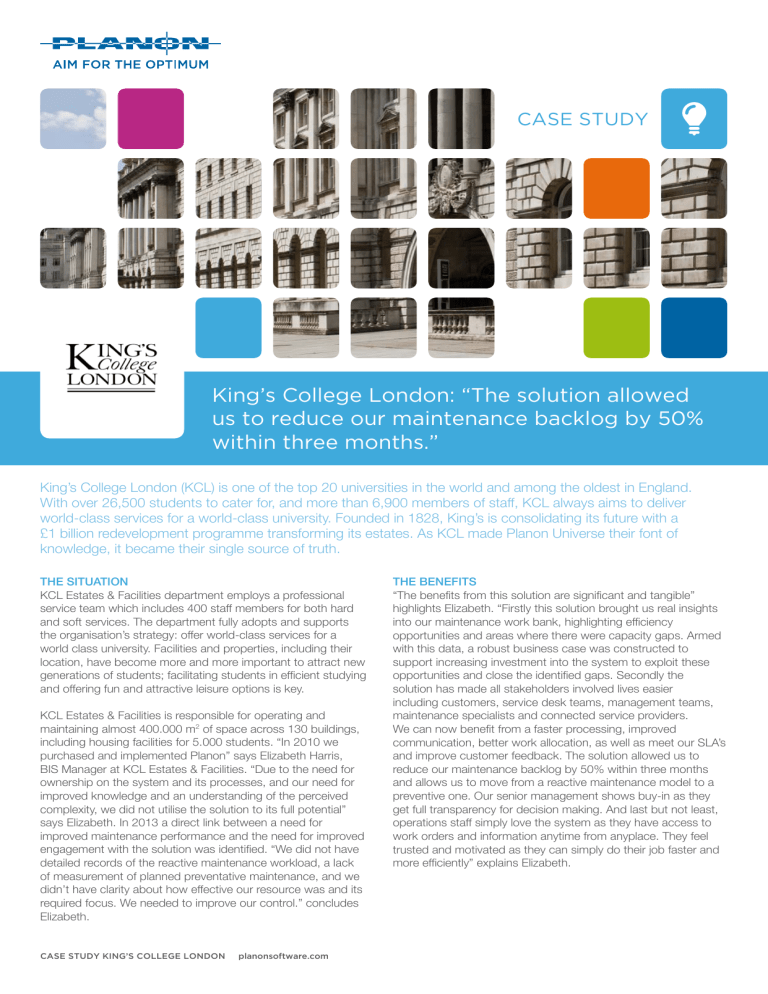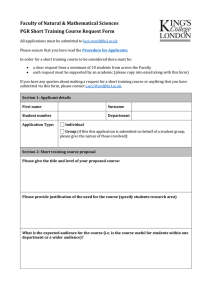Case Study - King`s College London

CASE STUDY
King’s College London: “The solution allowed us to reduce our maintenance backlog by 50% within three months.”
King’s College London (KCL) is one of the top 20 universities in the world and among the oldest in England.
With over 26,500 students to cater for, and more than 6,900 members of staff, KCL always aims to deliver world-class services for a world-class university. Founded in 1828, King’s is consolidating its future with a
£1 billion redevelopment programme transforming its estates. As KCL made Planon Universe their font of knowledge, it became their single source of truth.
THE SITUATION
KCL Estates & Facilities department employs a professional service team which includes 400 staff members for both hard and soft services. The department fully adopts and supports the organisation’s strategy: offer world-class services for a world class university. Facilities and properties, including their location, have become more and more important to attract new generations of students; facilitating students in efficient studying and offering fun and attractive leisure options is key.
KCL Estates & Facilities is responsible for operating and maintaining almost 400.000 m 2 of space across 130 buildings, including housing facilities for 5.000 students. “In 2010 we purchased and implemented Planon” says Elizabeth Harris,
BIS Manager at KCL Estates & Facilities. “Due to the need for ownership on the system and its processes, and our need for improved knowledge and an understanding of the perceived complexity, we did not utilise the solution to its full potential” says Elizabeth. In 2013 a direct link between a need for improved maintenance performance and the need for improved engagement with the solution was identified. “We did not have detailed records of the reactive maintenance workload, a lack of measurement of planned preventative maintenance, and we didn’t have clarity about how effective our resource was and its required focus. We needed to improve our control.” concludes
Elizabeth.
THE BENEFITS
“The benefits from this solution are significant and tangible” highlights Elizabeth. “Firstly this solution brought us real insights into our maintenance work bank, highlighting efficiency opportunities and areas where there were capacity gaps. Armed with this data, a robust business case was constructed to support increasing investment into the system to exploit these opportunities and close the identified gaps. Secondly the solution has made all stakeholders involved lives easier including customers, service desk teams, management teams, maintenance specialists and connected service providers.
We can now benefit from a faster processing, improved communication, better work allocation, as well as meet our SLA’s and improve customer feedback. The solution allowed us to reduce our maintenance backlog by 50% within three months and allows us to move from a reactive maintenance model to a preventive one. Our senior management shows buy-in as they get full transparency for decision making. And last but not least, operations staff simply love the system as they have access to work orders and information anytime from anyplace. They feel trusted and motivated as they can simply do their job faster and more efficiently” explains Elizabeth.
CASE STUDY KING’S COLLEGE LONDON planonsoftware.com
THE SOLUTION
As Planon Universe was already in place, the senior management decided to revitalise both the processes and the actual use of the system. “We started this new project with a clear goal in mind: we need PPM to be up and running in three months” states
Elizabeth. “We made Planon Universe our font of knowledge as it became our single source of truth. By increasing our internal knowledge, we could implement updates on a weekly basis. We set-up an internal Planon helpdesk, created specific training manuals, and started a simple but structured training for end users. All this effort led to huge operational benefits and a high acceptance rate, data just got better and better, and the number of users increased from 170 to 320 within a few months. With
Planon Mobile Field Services we managed to connect over 100 internal and external trade engineers to the system through their mobile devices. This allowed us to dispatch and execute maintenance work more efficiently and faster” concludes Elizabeth.
THE NEXT STEPS
KCL has a clear roadmap to further increase the use of Planon
Universe. A first project is to equip all additional 250 trade engineers with Planon Mobile Field Services. To further increase customer connection, Planon Self-Service will become available for both KCL employees and students. After completion of the
Maintenance Management solution, KCL will start implementing
Planon’s Real Estate Management solution and start using portfolio management and capital project management. Elizabeth concludes this case study with three key recommendations when implementing an IWMS system: “Make sure you manage the ownership of both the solution and the processes, know exactly what you want to achieve, and communicate with all the stakeholders involved.”
+26,500 students
+399,032 m 2 of estates
+5,000 student rooms to maintain
+400 staff in hard & soft services
“The solution allowed us to reduce our maintenance backlog by 50% within three months and allows us to move from a reactive maintenance model to a preventive one.”
ELIZABETH HARRIS, BIS MANAGER
CASE STUDY KING’S COLLEGE LONDON planonsoftware.com
